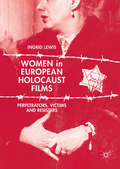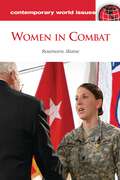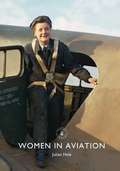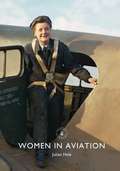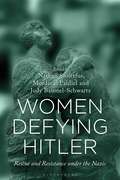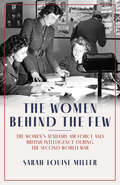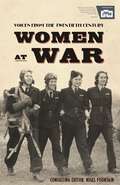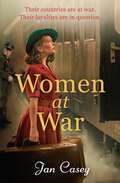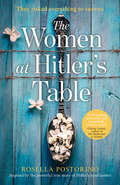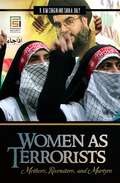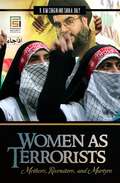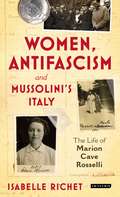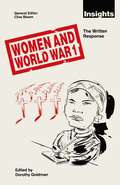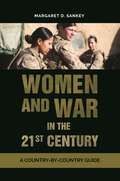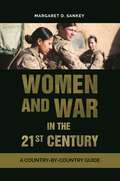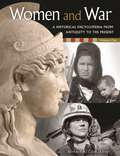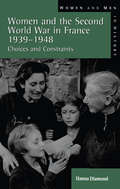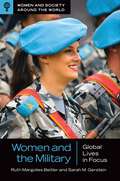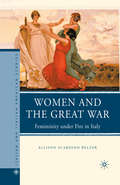- Table View
- List View
Women in European Holocaust Films: Perpetrators, Victims and Resisters
by Ingrid LewisThis book considers how women’s experiences have been treated in films dealing with Nazi persecution. Focusing on fiction films made in Europe between 1945 and the present, this study explores dominant discourses on and cinematic representation of women as perpetrators, victims and resisters. Ingrid Lewis contends that European Holocaust Cinema underwent a rich and complex trajectory of change with regard to the representation of women. This change both reflects and responds to key socio-cultural developments in the intervening decades as well as to new directions in cinema, historical research and politics of remembrance. The book will appeal to international scholars, students and educators within the fields of Holocaust Studies, Film Studies, European Cinema and Women’s Studies.
Women in European Holocaust Films: Perpetrators, Victims and Resisters
by Ingrid LewisThis book considers how women’s experiences have been treated in films dealing with Nazi persecution. Focusing on fiction films made in Europe between 1945 and the present, this study explores dominant discourses on and cinematic representation of women as perpetrators, victims and resisters. Ingrid Lewis contends that European Holocaust Cinema underwent a rich and complex trajectory of change with regard to the representation of women. This change both reflects and responds to key socio-cultural developments in the intervening decades as well as to new directions in cinema, historical research and politics of remembrance. The book will appeal to international scholars, students and educators within the fields of Holocaust Studies, Film Studies, European Cinema and Women’s Studies.
Women in Combat: A Reference Handbook (Contemporary World Issues)
by Rosemarie SkaineThis handbook provides a straightforward account of how women have served in combat roles and explains the ongoing controversy surrounding efforts to legalize combat assignments for female service members.Women have been excluded from combat roles for most of American history. During conflicts such as the American Civil War, a few women enlisted as men; in some cases, their identities as women were not discovered until after their deaths. Today, the nontraditional battlefields of Iraq and Afghanistan have no clearly defined front lines, and many female soldiers have found themselves face-to-face with the enemy. Yet despite the realities of modern warfare, the subject of women serving in combat roles remains highly controversial.Women in Combat: A Reference Handbook examines the historical background, current dilemmas, and global context of this contentious issue. The author explores both sides of the argument, presenting information from leading sources and gleaned from personal interviews. Statistical data, primary source documents, a directory of organizations, and print and electronic resources offer additional insight.
Women in Combat: A Reference Handbook (Contemporary World Issues)
by Rosemarie SkaineThis handbook provides a straightforward account of how women have served in combat roles and explains the ongoing controversy surrounding efforts to legalize combat assignments for female service members.Women have been excluded from combat roles for most of American history. During conflicts such as the American Civil War, a few women enlisted as men; in some cases, their identities as women were not discovered until after their deaths. Today, the nontraditional battlefields of Iraq and Afghanistan have no clearly defined front lines, and many female soldiers have found themselves face-to-face with the enemy. Yet despite the realities of modern warfare, the subject of women serving in combat roles remains highly controversial.Women in Combat: A Reference Handbook examines the historical background, current dilemmas, and global context of this contentious issue. The author explores both sides of the argument, presenting information from leading sources and gleaned from personal interviews. Statistical data, primary source documents, a directory of organizations, and print and electronic resources offer additional insight.
Women in Aviation (Shire Library)
by Julian HaleThis title explores the scope of women's activities in aviation, from the time of the Wright Brothers to the present day. After highlighting the earliest female aviators, as well as the trailblazers of the inter-war period such as Amy Johnson and Amelia Earhart, the book goes on to examine the experience of women in aviation during the Second World War, including those flying with the Air Transport Auxiliary and the American Women Airforce Service Pilots. The post-war years are also covered and the title emphasises the growth in women's participation in civil and military spheres of aviation – by the last decades of the twentieth century, women had progressed even further, undertaking many of the jobs previously reserved for men, including space flight and combat flying. From the earliest women to obtain pilot's licenses to the female astronauts of the modern day, this is a concise introduction to the development of British and American women's roles in aviation.
Women in Aviation (Shire Library #865)
by Julian HaleThis title explores the scope of women's activities in aviation, from the time of the Wright Brothers to the present day. After highlighting the earliest female aviators, as well as the trailblazers of the inter-war period such as Amy Johnson and Amelia Earhart, the book goes on to examine the experience of women in aviation during the Second World War, including those flying with the Air Transport Auxiliary and the American Women Airforce Service Pilots. The post-war years are also covered and the title emphasises the growth in women's participation in civil and military spheres of aviation – by the last decades of the twentieth century, women had progressed even further, undertaking many of the jobs previously reserved for men, including space flight and combat flying. From the earliest women to obtain pilot's licenses to the female astronauts of the modern day, this is a concise introduction to the development of British and American women's roles in aviation.
Women Defying Hitler: Rescue and Resistance under the Nazis
by Nathan Stoltzfus, Mordecai Paldiel, and Judy Baumel-SchwartzThis timely volume brings together an international team of leading scholars to explore the ways that women responded to situations of immense deprivation, need, and victimization under Hitler's dictatorship. Paying acute attention to the differences that gender made, Women Defying Hitler examines the forms of women's defiance, the impact these women had, and the moral and ethical dilemmas they faced. Several essays also address the special problems of the memory and historiography of women's history during World War II, and the book features standpoints of historians as well as the voices of survivors and their descendants. Notably, this book also serves as a guide for human behaviour under extremely difficult conditions. The book is relevant today for challenging discrimination against women and for its nuanced exploration of the conditions minorities face as outspoken protagonists of human rights issues and as resisters of discrimination. From this perspective the voices being empowered in this book are clear examples of the importance of protest by women in forcing a totalitarian regime to pause and reconsider its options for the moment. In revealing so, Women Defying Hitler ultimately foregrounds that women rescuers and resisters were and are of great continuing consequence.
Women Defying Hitler: Rescue and Resistance under the Nazis
This timely volume brings together an international team of leading scholars to explore the ways that women responded to situations of immense deprivation, need, and victimization under Hitler's dictatorship. Paying acute attention to the differences that gender made, Women Defying Hitler examines the forms of women's defiance, the impact these women had, and the moral and ethical dilemmas they faced. Several essays also address the special problems of the memory and historiography of women's history during World War II, and the book features standpoints of historians as well as the voices of survivors and their descendants. Notably, this book also serves as a guide for human behaviour under extremely difficult conditions. The book is relevant today for challenging discrimination against women and for its nuanced exploration of the conditions minorities face as outspoken protagonists of human rights issues and as resisters of discrimination. From this perspective the voices being empowered in this book are clear examples of the importance of protest by women in forcing a totalitarian regime to pause and reconsider its options for the moment. In revealing so, Women Defying Hitler ultimately foregrounds that women rescuers and resisters were and are of great continuing consequence.
The Women Behind the Few: The Women’s Auxiliary Air Force and British Intelligence during the Second World War
by Sarah-Louise Miller“Richly illuminating, this is a powerful and deeply engrossing history of the women whose unsung war work was consigned for so many years to the shadows.” – Sinclair McKay, author of The Secret Life of Bletchley Park“Vividly written and based on superb research, this is undoubtedly one of the best books on the role of women at war so far.” – Michael Smith, author of The Secrets of Station X“Captivating … I was hooked from page one.” – Lucy Fisher, author of Women in the War“A compulsively readable group portrait of women who operated in almost every aspect of British intelligence. Meticulously researched and compellingly written – a triumph!” – Professor Richard J. Aldrich, author of GCHQ“At the beginning of the Second World War, the prevailing view was that women didn’t have the education, intellect or ability for intelligence work. With a lively mix of personal testimony and scholarly analysis, Sarah-Louise Miller shows how in fact women performed superb work in the WAAF, restoring them to their rightful place in the full narrative of the conflict.” – Taylor Downing, author of Spies in the Sky“The vital contribution of the enterprising and courageous women who helped to win the battle of the air in the Second World War is brought to life in Sarah-Louise Miller’s important and absorbing book.” – Wendy Moore, author of Endell Street“An animated, in-depth account of the crucial role of the Women’s Auxiliary Air Force in the intelligence services during the Second World War … An important and welcome addition to scholarship on wartime women.” – Professor Penny Summerfield, University of Manchester“A rip-roaring read.” – Professor Michael Goodman, King’s College London***‘Never in the field of human conflict was so much owed by so many to so few.’The courageous pilots of the Royal Air Force who faced the Luftwaffe in the Battle of Britain, affectionately known as ‘the Few’, are rightly hailed as heroes. Recently, efforts have been made to recognise the thousands who supported RAF operations behind the scenes. And yet one group remains missing from the narrative: the Women’s Auxiliary Air Force.The Women Behind the Few explores the Second World War from the perspective of the WAAFs working behind the scenes to collect and disseminate vital intelligence – intelligence that resulted in Allied victory.WAAFs worked within the Dowding System, the world’s most sophisticated air defence network, as well as in the Y Service, intercepting German communications. Throughout the Blitz, they used radar to aid Fighter and Bomber Commands in protecting Britain’s civilians.WAAFs also assisted with the Allied offensive bombing campaign and were behind the discovery of the terrifying German V-weapons. Their work was critical ahead of the Normandy landings and they were present in their hundreds at Bletchley Park.In this thrilling book, Sarah-Louise Miller brings the women of the force back to life, celebrating their wartime contribution to British military intelligence. Hidden behind the Few but vital to their success, WAAFs supplied the RAF with life-saving information. Here, for the first time, is their story.
Women At War 1914-91: Voices Of The Twentieth Century
by Nigel FountainWomen at War captures the reality of women at war in their own words, examining the enormously important part that women played in the major wars of the twentieth century. From their involvement in the First World War - as munitions workers, land girls, postal workers, drivers, as well as nurses and in the women's corps of the armed services that were established towards the war's end - their role increased with every major conflict of the 20th century. With black and white illustrations throughout.
Women at War
by Jan CaseyTwo women. One war. For Viola Baxter, 1939 was supposed to be a wonderful year. After meeting and falling in love with dashing Fred Scholz at Cambridge University, they planned to marry and start their new lives together. She never imagined her father would say no to the marriage. Fred is half-German and, with war fast approaching, he must travel to Germany to bring his sister home. But that journey is enough for others to suspect him... and Viola.When Annie Scholz heard her beloved grandmother was seriously ill, she wasted no time rushing to Germany to be by her side. She didn't realise it meant she would not be able to return home to the UK, or that her decision would endanger her brother, Fred, as well. Even reuniting with her childhood beau is bittersweet – how can she love someone who stands for everything she opposes? With everyone watching Annie and Fred so closely, there is no room for error... or dangerous resistance.With war the only certainty, there's just one thing in question: where do Viola and Annie's loyalties lie? Women at War is the thrilling and heart-wrenching new WW2 story from Jan Casey, author of The Women of Waterloo Bridge. What readers are saying about Women at War: '[A] captivating, heart wrenching saga... I adamantly recommend' - 5* reader review'A story of courage and hope' - 5* reader review'I love this book... This book drew me in straight away and I just wanted to keep on reading until I finished it. A lovely story' - 5* reader review'Poignant, warm, gut wrenching and hopeful, this book is just beautiful. I stayed riveted the entire time and could not put it down' - 5* reader review'The book is full of fervor and the characters grow from beginning to end! I could not put the book down!' - 5* reader review
The Women at Hitler’s Table
by Rosella Postorino‘Written with intelligence and nuance’ The Times ‘A disturbing, powerful and beautifully written novel based on shockingly real events’ Christy Lefteri, author of The Beekeeper of Aleppo ‘A thought-provoking read’ My Weekly ‘Unputdownable’ The Herald
Women as Terrorists: Mothers, Recruiters, and Martyrs (Praeger Security International)
by R. Kim Cragin Sara A. DalyTwo international policy analysts scrutinize the increasingly important operative and support roles women play in various terrorist organizations around the world.Women as Terrorists: Mothers, Recruiters, and Martyrs is the first post-September 11 book to examine women's multifarious roles in terrorist organizations of all stripes around the world. It covers political, religious, ethno-separatist, and Maoist groups in countries as diverse as Iraq, Palestine, Chechnya, Sri Lanka, Colombia, South Africa, the Philippines, and Northern Ireland. Modeling terrorist organizations as purposive organizations that depend for support, recruitment, and rationale on a culturally defined community of sympathizers, the authors explore why women become involved in terrorist groups, how terrorist leaders turn the societal attributes of women to advantage in designing terrorist campaigns, and how women fight for the right to assume strategic and combat roles in terrorist groups. The authors conclude with a review and projection of the rapidly evolving trends in the use of women in terrorist organizations, paying particular attention to al-Qaeda and its affiliated groups and considering the implications of their findings for counterterrorist strategies.
Women as Terrorists: Mothers, Recruiters, and Martyrs (Praeger Security International)
by R. Kim Cragin Sara A. DalyTwo international policy analysts scrutinize the increasingly important operative and support roles women play in various terrorist organizations around the world.Women as Terrorists: Mothers, Recruiters, and Martyrs is the first post-September 11 book to examine women's multifarious roles in terrorist organizations of all stripes around the world. It covers political, religious, ethno-separatist, and Maoist groups in countries as diverse as Iraq, Palestine, Chechnya, Sri Lanka, Colombia, South Africa, the Philippines, and Northern Ireland. Modeling terrorist organizations as purposive organizations that depend for support, recruitment, and rationale on a culturally defined community of sympathizers, the authors explore why women become involved in terrorist groups, how terrorist leaders turn the societal attributes of women to advantage in designing terrorist campaigns, and how women fight for the right to assume strategic and combat roles in terrorist groups. The authors conclude with a review and projection of the rapidly evolving trends in the use of women in terrorist organizations, paying particular attention to al-Qaeda and its affiliated groups and considering the implications of their findings for counterterrorist strategies.
Women, Antifascism and Mussolini’s Italy: The Life of Marion Cave Rosselli (International Library of Twentieth Century History #128)
by Isabelle RichetMarion Cave Rosselli is remembered as the 'perfect companion' of the Italian Antifascist leader Carlo Rosselli, assassinated in Paris in June 1937. But little is known about the young English student fired with revolutionary enthusiasm who moved to Florence in 1919, witnessed the violent march of fascism to power and thereafter became a resolute adversary of the Mussolini dictatorship. Based on a wealth of little-used private and public archives, this biography retraces her journey from a modest home on the outskirts of London to the first underground Antifascist opposition in Italy, from the prison island of Lipari to exile in Paris and the United States. It reveals the social, cultural and existential factors which underpinned her unflinching political engagement alongside her husband. It also highlights the many challenges faced by Antifascist women within a highly patriarchal movement by bringing to life the figure of a woman who challenged the traditional division of labour within the family and struggled to carve a political role for herself. Reconstructing Marion Cave Rosselli's experience in relation to the multiple political, social and cultural worlds she moved in, this book broadens our understanding of the Antifascist movement and offers a richly detailed portrait of a time full of hopes, anxieties and disappointments.
Women, Antifascism and Mussolini’s Italy: The Life of Marion Cave Rosselli (International Library of Twentieth Century History)
by Isabelle RichetMarion Cave Rosselli is remembered as the 'perfect companion' of the Italian Antifascist leader Carlo Rosselli, assassinated in Paris in June 1937. But little is known about the young English student fired with revolutionary enthusiasm who moved to Florence in 1919, witnessed the violent march of fascism to power and thereafter became a resolute adversary of the Mussolini dictatorship. Based on a wealth of little-used private and public archives, this biography retraces her journey from a modest home on the outskirts of London to the first underground Antifascist opposition in Italy, from the prison island of Lipari to exile in Paris and the United States. It reveals the social, cultural and existential factors which underpinned her unflinching political engagement alongside her husband. It also highlights the many challenges faced by Antifascist women within a highly patriarchal movement by bringing to life the figure of a woman who challenged the traditional division of labour within the family and struggled to carve a political role for herself. Reconstructing Marion Cave Rosselli's experience in relation to the multiple political, social and cultural worlds she moved in, this book broadens our understanding of the Antifascist movement and offers a richly detailed portrait of a time full of hopes, anxieties and disappointments.
Women and World War 1: The Written Response (Insights)
by Dorothy GoldmanThe literary canon of World War 1 - celebrated for realising the experience of an entire generation - ignores writing by women. To the sorrows that war has always brought them - the loss of husbands, lovers, brothers - the Great War added a revolutionary knowledge. And all the time they wrote - letters, poetry, novels, short stories, memoirs. This volume of mutually reflective essays brings this writing into literary focus and ensures that women's recent history and literature are neither forgotten nor undervalued.
Women and War in the 21st Century: A Country-by-Country Guide
by Margaret D. SankeyTwenty-three countries currently allow women to serve in front-line combat positions and others with a high likelihood of direct enemy contact. This book examines how these decisions did or did not evolve in 47 countries.This timely and fascinating book explores how different countries have determined to allow women in the military to take on combat roles—whether out of a need for personnel, a desire for the military to reflect the values of the society, or the opinion that women improve military effectiveness—or, in contrast, have disallowed such a move on behalf of the state. In addition, many countries have insurgent or dissident factions, in that have led armed resistance to state authority in which women have been present, requiring national militaries and peacekeepers to engage them, incorporate them, or disarm and deradicalize them.This country-by country analysis of the role of women in conflicts includes insightful essays on such countries as Afghanistan, China, Germany, Iraq, Israel, Russia, and the United States. Each essay provides important background information to help readers to understand the cultural and political contexts in which women have been integrated into their countries' militaries, have engaged in combat during the course of conflict, and have come to positions of political power that affect military decisions.
Women and War in the 21st Century: A Country-by-Country Guide
by Margaret D. SankeyTwenty-three countries currently allow women to serve in front-line combat positions and others with a high likelihood of direct enemy contact. This book examines how these decisions did or did not evolve in 47 countries.This timely and fascinating book explores how different countries have determined to allow women in the military to take on combat roles—whether out of a need for personnel, a desire for the military to reflect the values of the society, or the opinion that women improve military effectiveness—or, in contrast, have disallowed such a move on behalf of the state. In addition, many countries have insurgent or dissident factions, in that have led armed resistance to state authority in which women have been present, requiring national militaries and peacekeepers to engage them, incorporate them, or disarm and deradicalize them.This country-by country analysis of the role of women in conflicts includes insightful essays on such countries as Afghanistan, China, Germany, Iraq, Israel, Russia, and the United States. Each essay provides important background information to help readers to understand the cultural and political contexts in which women have been integrated into their countries' militaries, have engaged in combat during the course of conflict, and have come to positions of political power that affect military decisions.
Women and War [2 volumes]: A Historical Encyclopedia from Antiquity to the Present [2 volumes]
by Bernard A. CookIn this unique encyclopedia, 120 leading scholars from around the world provide comprehensive treatment of the role of women in war, from the first written history to the present.This authoritative encyclopedia presents the work of leading scholars from all over the world to give the first detailed coverage of the role of women in wars throughout history. Histories of war are typically histories of men: great leaders and heroic fighters. Yet the roles of women often receive only limited coverage.Except for such notables as Joan of Arc, traditional histories give short shrift to women as leaders and fighters. Similarly, the direct victimization—particularly sexual abuse as a weapon of terror and domination—and cultural dislocations women suffer in war float as background, without detailed coverage. This work represents a first, devoted in its entirety to thorough examination of all aspects of women in war. For the first time, readers have a single source for information on the scope of women's role in war, and war's effects on them.
Women and the Second World War in France, 1939-1948: Choices and Constraints (Women And Men In History)
by Hanna DiamondThis is the first book (in either English or French) to offer readers an overview of women's experience of the Second World War and its immediate aftermath in France. It examines objectively the part that women played in both collaboration and resistance, synthesising much recent scholarship on the subject in French and English, and drawing on the author's own extensive research (including oral testimony) in Toulouse, Paris, and West Brittany. The findings are complex, and the immensely varied testimony challenges easy generalisation. This will be relevant for courses on French studies, French and European history and Women's studies.
Women and the Second World War in France, 1939-1948: Choices and Constraints (Women And Men In History)
by Hanna DiamondThis is the first book (in either English or French) to offer readers an overview of women's experience of the Second World War and its immediate aftermath in France. It examines objectively the part that women played in both collaboration and resistance, synthesising much recent scholarship on the subject in French and English, and drawing on the author's own extensive research (including oral testimony) in Toulouse, Paris, and West Brittany. The findings are complex, and the immensely varied testimony challenges easy generalisation. This will be relevant for courses on French studies, French and European history and Women's studies.
Women and the Military: Global Lives in Focus (Women and Society around the World)
by Ruth Margolies Beitler Sarah M. GersteinThis addition to the Women and Society around the World series explores the roles, challenges, and accomplishments of women in the military in countries across the globe.Around the world, millions of men serve in their countries' militaries, be it on land, on the seas, or in the air. But while many militaries have opened all positions to women, even those on the front lines, others remain closed. Countries have cited a number of reasons for their policies, including changing views of women and the military, conscription, and economic and demographic trends. Written by a professor of comparative politics at the United States Military Academy at West Point and an active duty army major, this book seeks to provide an understanding of women's roles in militaries around the world. The book is organized by region, exploring societal and cultural views of masculinity and war, as well as factors influencing changing views of women and the military, including conscription and economic and demographic trends. Topics also include sexual harassment, recruitment, and views on women's physicality and strength. High school students, undergraduates, and general readers will find this cross-cultural study a fascinating and important resource.
Women and the Military: Global Lives in Focus (Women and Society around the World)
by Ruth Margolies Beitler Sarah M. GersteinThis addition to the Women and Society around the World series explores the roles, challenges, and accomplishments of women in the military in countries across the globe.Around the world, millions of men serve in their countries' militaries, be it on land, on the seas, or in the air. But while many militaries have opened all positions to women, even those on the front lines, others remain closed. Countries have cited a number of reasons for their policies, including changing views of women and the military, conscription, and economic and demographic trends. Written by a professor of comparative politics at the United States Military Academy at West Point and an active duty army major, this book seeks to provide an understanding of women's roles in militaries around the world. The book is organized by region, exploring societal and cultural views of masculinity and war, as well as factors influencing changing views of women and the military, including conscription and economic and demographic trends. Topics also include sexual harassment, recruitment, and views on women's physicality and strength. High school students, undergraduates, and general readers will find this cross-cultural study a fascinating and important resource.
Women and the Great War: Femininity under Fire in Italy (Italian and Italian American Studies)
by A. BelzerDrawing on both wartime discourse about women and the voices of individual women living at the Italian Front, Allison Belzer analyzes how women participated in the Great War and how it affected them. The Great War transformed women into purveyors and recipients of a new feminine ideal that emphasized their status as national citizens. Although Italian women did not gain the vote, they did encounter a less empowering form of female citizenship just after the war ended with Mussolini's Fascism. Because of the Great War, many women seized the opportunity to participate in a society that continued to recognize them as guardians of the nation.
